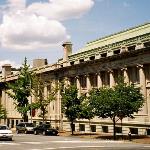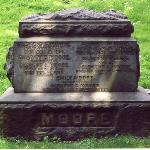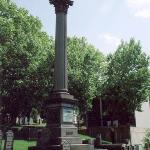Trinity Cemetery was then [1860] enclosed by a high board fence, painted gray-blue. The horizontal boards were fastened to rough posts which were hidden by two vertical boards nailed on each side of the post and meeting outside it at an angle. In the high triangular chambers thus formed, there was often much space between the post and the boards, and here the flying squirrels used to make their nests.
George Bird Grinnell
Natural History Magazine
January/February 1920
Very few interments now take place, no new lots being available, as the ground is within the city limits, and there is a growing fear that at no distant day enterprising New york will desire this spot for business, for what a few years since was all open country is now covered with great buildings, and numberless apartment houses and stores are at its very side. In spite of this, New Yorkers love it still.
New York Times
September 21, 1902
Today the Trinity Church Cemetery and Mausoleum continue to serve the needs of New Yorkers. The Trinity Church Garden Mausoleum offers above-ground burial for those selecting traditional burial or cremation.
2007
Now, start down the hill towards the river. You are walking along the rear of the Audubon Terrace museum complex, but notice how even the rear exteriors of these magnificent Beaux arts structures are beautifully finished. Just past the middle of the block, if you look across 155th Street at the cemetery from the end of April to the middle of May, you will see blooming pink and white dogwood trees – a species that once covered this entire slope. Just a little further on, you might want to pause to admire the bronze doors that Adolph A Weinman’s created for the rear of the American Academy of Arts and Letters. Weinman, who was elected to the Academy in 1910, dedicated these doors (as you can read above them) to “Mary Wilkins Freeman and the woman writers of America.” The architectural firm of McKim, Meade and White, all three of whom were academy members, designed this building.
The Hudson River
When you reach the corner, cross the street and walk along the sidewalk, with benches and a low wall to your left. Continue walking to the end of the wall, then turn left and walk to the middle of the cement plaza where you will have a view of the Hudson River and downtown Manhattan. In the mid-distance, you can see Riverside Church's tower, at the right, and in the far distance, you can see the top of the Empire State Building. If you turn 180 degrees and look up the river, you will see the George Washington Bridge, which opened on Sunday, October 25, 1931.
From your present angle, the bridge obscures most of the magnificent Palisades on the New Jersey side of the river, but in 1842, you would have had a spectacular view of both the river and the Palisades from Audubon’s house. Directly below you in Trinity cemetery is a simple gravestone marking the burial place of Clement Clarke Moore, theologian and scholar, and best remembered today as the author of “A Visit from St. Nicholas” (Twas the night before Christmas and all through the house…). When the trees are bare, you have a splendid view of the ascending rows of vaults on its steep slope.
The most arresting monument in this side of the cemetery is the tall pedestal in the foreground. Atop it is a woman in classical robes, looking out over the Hudson. In her left hand, she holds an anchor. This monument is dedicated to Stephen H Tyng, Jr who, as the inscription at the base tells us, was lost at sea on May 1, 1918 in the service of his country, just days before the end of The Great War.
 | ||||
 | ||||
Audubon Terrace: 155th Street
(click to enlarge)
 | ||||
Tyng Monument
in Trinity Cemetery
(click to enlarge)
Clement Clarke Moore Grave
(click to enlarge)
Continue your walk . . .
Funded by the Audubon Park Alliance


